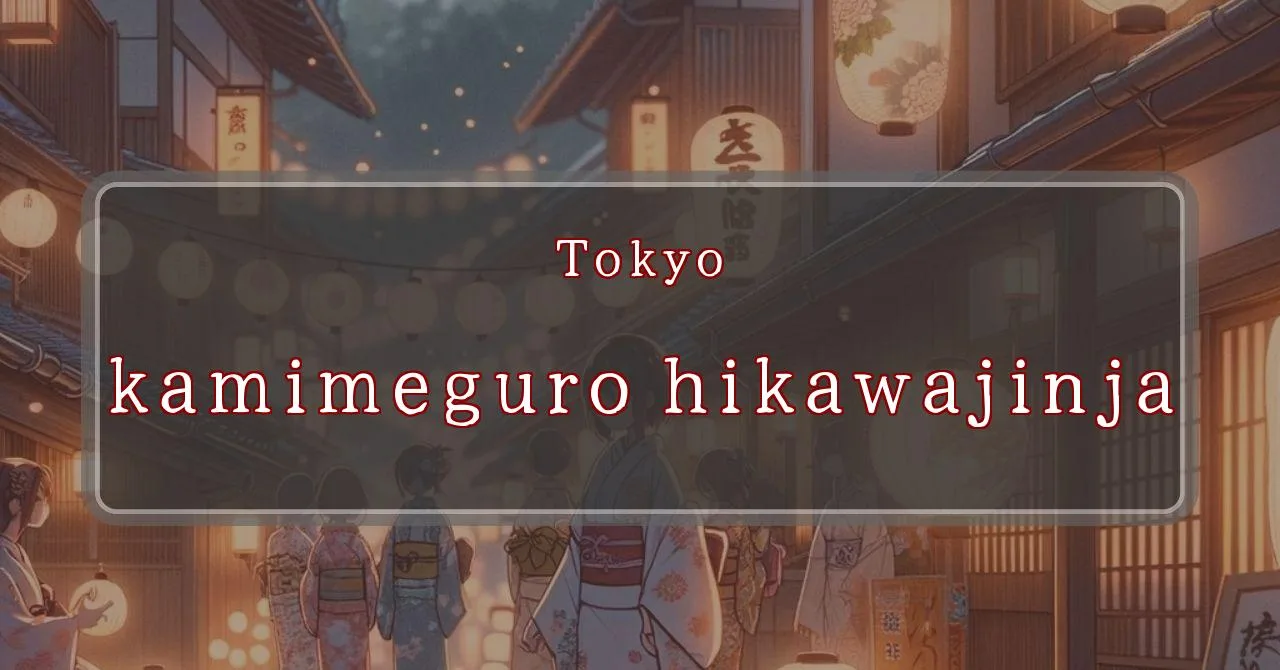Enchanting melodies and vibrant floats fill the streets of Kamimeguro
Shinto shrine located in Kamimeguro, Meguro, Tokyo, Japan. It is dedicated to Susanoo-no-Mikoto, the god of storms, seas, and agriculture.
- Address: 2-16-21 Ohashi, Meguro-ku, Tokyo 153-0044
- Phone Number: 03-3466-2507
- Access: 5-minute walk from Ikejiri-Ohashi Station on the Tokyu Den-en-toshi Line
- Festival Days: August 27th (Sat) and 28th (Sun), 2024
Main Events and Attractions of the Festival
The Kamimeguro Hikawa Shrine Festival is a vibrant and lively event that offers a variety of attractions for visitors of all ages. Some of the main highlights include:
Mikoshi Procession
One of the central attractions of the festival is the mikoshi procession, where a portable shrine is carried through the streets of Kamimeguro. The mikoshi is elaborately decorated and carried by a team of people, accompanied by traditional music and dance. Visitors can witness this spectacle and experience the lively atmosphere of the festival.
Traditional Performances
The festival also features a variety of traditional Japanese performances, including taiko drumming, kagura dance, and koto music. These performances showcase Japan’s rich cultural heritage and provide a glimpse into the country’s traditional arts. Visitors can enjoy these performances and learn more about Japanese culture.
Food and Market Stalls
The festival grounds are lined with food and market stalls, offering a wide range of delicious treats and local specialties. Visitors can indulge in traditional Japanese dishes, such as yakitori, takoyaki, and okonomiyaki, as well as a variety of other culinary delights. There are also stalls selling souvenirs and crafts, providing an opportunity for visitors to take home a memento of the festival.
Fireworks Display
The festival culminates in a spectacular fireworks display, which lights up the night sky over Kamimeguro. Visitors can gather in the festival grounds or find a spot along the Meguro River to enjoy the dazzling display of fireworks.
Blessings and Deities
Kamimeguro Hikawa Shrine is dedicated to Susanoo-no-Mikoto, the Shinto god of storms, seas, and agriculture. Susanoo-no-Mikoto is known for his fierce and powerful nature, but he is also revered as a protective deity who brings blessings and good fortune. Visitors to the shrine can pray for success in various aspects of life, including health, wealth, and relationships.
- Susanoo-no-Mikoto: God of storms, seas, and agriculture; revered as a protective deity who brings blessings and good fortune.
- Amaterasu Omikami: Goddess of the sun and the universe; known for her benevolence and nurturing qualities.
- 菅原道真: God of scholarship and learning; revered for his wisdom and academic achievements.
Origin and History
The origins of Kamimeguro Hikawa Shrine are shrouded in mystery, but it is believed to have been founded during the Heian period (794-1185). The shrine was initially a small shrine dedicated to Susanoo-no-Mikoto, but it gradually grew in size and importance over the centuries. In the Edo period (1603-1868), the shrine became a popular destination for pilgrims and worshippers from all over Japan.
- Heian period (794-1185): Believed to have been founded during this period.
- Edo period (1603-1868): Became a popular destination for pilgrims and worshippers.
- Meiji period (1868-1912): Designated as a village shrine under the new shrine ranking system.
- Present day: Continues to be a popular shrine for locals and visitors alike.
Tips and Notes for Visitors
Here are some tips and notes for visitors to Kamimeguro Hikawa Shrine:
- Dress respectfully: When visiting the shrine, it is important to dress respectfully. This means avoiding shorts, tank tops, and other casual clothing.
- Purify yourself before entering: Before entering the shrine, it is customary to purify yourself by washing your hands and rinsing your mouth at the chozuya (water purification basin).
- Offer a monetary offering: When making an offering at the shrine, it is customary to use a 5-yen coin. This is because the Japanese word for “5 yen” (go-en) is a homophone for the word for “good luck” (go-en).
- Write a wish on an ema: Ema are wooden plaques that are used to write wishes and prayers. Visitors can purchase an ema at the shrine and write their wishes on it, then hang it on a designated rack.
- Receive a fortune: Visitors can also receive a fortune (omikuji) at the shrine. To do this, shake the omikuji box until a stick falls out. The stick corresponds to a drawer that contains a fortune slip.
Parking Information
There is limited parking available at Kamimeguro Hikawa Shrine. Visitors are advised to use public transportation or park in a nearby parking lot and walk to the shrine.
- Limited parking available at the shrine: First-come, first-served basis.
- Nearby parking lots: Several parking lots are located within walking distance of the shrine.
- Public transportation: The shrine is a 5-minute walk from Ikejiri-Ohashi Station on the Tokyu Den-en-toshi Line.
Popular Stalls and Food Carts in Recent Years
| Type of Stall | Description |
|---|---|
| Takoyaki | A staple at Japanese festivals. Characterized by a crispy outside and a creamy inside. |
| Jaga Butter | A simple yet popular snack of hot potatoes lavishly topped with melted butter. |
| Baby Castella | Small castella cakes, sweet and fluffy treats enjoyed by children and adults alike. |
| Grilled Ayu with Salt | Fresh ayu fish grilled whole with salt, a savory taste of Japanese summer. |
| Shaapin | A unique gourmet item influenced by foreign cuisine, with a chewy skin wrapping the filling. |
| Okonomiyaki | A Japanese grilled dish where you often choose your own ingredients for a personalized flavor. |
| Cotton Candy | A fluffy, sweet snack that’s extremely popular with children. |
| Chocolate Banana | A banana coated in chocolate, a fun and visually appealing dessert. |
| Kushiyaki | Various types of ingredients skewered and grilled, an easy-to-enjoy snack. |
| Yakisoba | Fried noodles mixed with a special sauce, a fast food favorite in Japan. |



